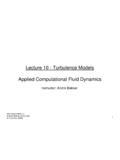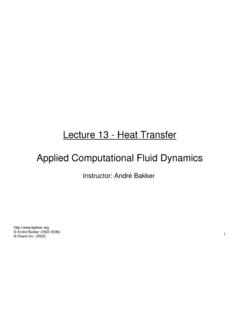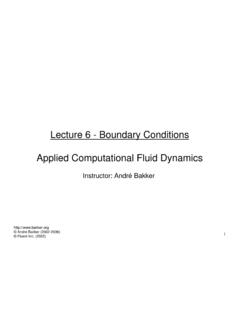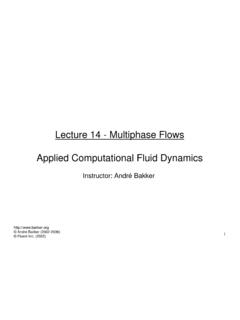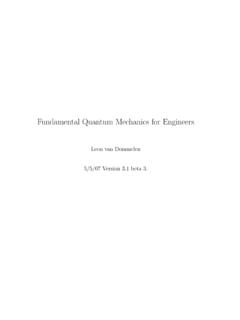Transcription of Lecture 3 - Conservation Equations Applied Computational ...
1 1 Lecture 3 - Conservation EquationsApplied Computational Fluid DynamicsInstructor: Andr Andr Bakker (2002-2006)2 The governing Equations include the following Conservation laws of physics : Conservation of mass. Newton s second law: the change of momentum equals the sum of forces on a fluid particle. First law of thermodynamics ( Conservation of energy): rate of change of energy equals the sum of rate of heat addition to and work done on fluid particle. The fluid is treated as a continuum. For length scales of, say, 1 m and larger, the molecular structure and motions may be equations3 Lagrangian vs. Eulerian descriptionA fluid flow field can be thought of as being comprised of a large number of finite sized fluid particleswhich have mass, momentum, internal energy, and other properties.
2 Mathematical laws can then be written for each fluid particle. This is the Lagrangian description of fluid view of fluid motion is the Eulerian description. In the Eulerian description of fluid motion, we consider how flow properties change at a fluid elementthat is fixed in space and time (x,y,z,t), rather than following individual fluid Equations can be derived using each method and converted to the other element and properties The behavior of the fluid is described in terms of macroscopic properties: Velocity u. Pressure p. Density . Temperature T. Energy E. Typically ignore (x,y,z,t) in the notation. Properties are averages of a sufficiently large number of molecules. A fluid element can be thought of as the smallest volume for which the continuum assumption is y x z(x,y,z)Fluid element for Conservation lawsFaces are labeled North, East, West, South, Top and Bottom1122 WEppppxppxxx = =+ Properties at faces are expressed as firsttwo terms of a Taylor series expansion, for p :and5 Mass balance Rate of increase of mass in fluid element equals the net rate offlow of mass into element.
3 Rate of increase is: The inflows (positive) and outflows (negative) are shown here:zyxtzyxt = )(xyz() yz + () zy + zyxxuu 21.)(zxyyvv 21.)(yxzzww 21.)(() zx + 6 Continuity equation Summing all terms in the previous slide and dividing by the volume x y zresults in: In vector notation: For incompressible fluids / t= 0, and the equation becomes: div u= 0. Alternative ways to write this: and0)()()(= + + + zwyvxut 0)(=+ u divtChange in densityNet flow of mass across boundariesConvective term0= + + zwyvxu0= iixu7 Different forms of the continuity equationformonConservatiformIntegraldVtS V0= + dSU formonconservatiNonformIntegraldVDtDV = 0 formonConservatiformalDifferentit0)(= + U formonconservatiNonformalDifferentiDtD = +0U Infinitesimally smallelement fixed in spaceInfinitesimally small fluid element of fixed mass ( fluid particle ) moving with the flowFinite control volumefixed in spaceFinite control volume fixed mass moving with flowU8 Rate of change for a fluid particle Terminology.
4 Fluid element is a volume stationary in space, and a fluid particle is a volume of fluid moving with the flow. A moving fluid particle experiences two rates of changes: Change due to changes in the fluid as a function of time. Change due to the fact that it moves to a different location in the fluid with different conditions. The sum of these two rates of changes for a property per unit mass is called the totalor substantivederivative D /Dt: With dx/dt=u, dy/dt=v, dz/dt=w, this results in:dtdzzdtdyydtdxxtDtD + + + = + =9 Rate of change for a stationary fluid element In most cases we are interested in the changes of a flow property for a fluid element, or fluid volume, that is stationary in space. However, some Equations are easier derived for fluid particles.
5 For a moving fluid particle, the total derivative per unit volume of this property is given by: For a fluid element, for an arbitrary conserved property : + = )(=+ u divt0)()(=+ u divtContinuity equationArbitrary property(for moving fluid particle) (for given location in space)10 DtDdivtgradtdivt = + + + =+ )(.)()(uuuzero because of continuityDtDdivt =+ )()(uRate of increase of of fluid elementNet rate of flow of out of fluid elementRate of increase of for a fluid particle=Fluid particle and fluid element We can derive the relationship between the Equations for a fluidparticle (Lagrangian) and a fluid element (Eulerian) as follows:11To remember so far We need to derive Conservation Equations that we can solve to calculate fluid velocities and other properties.
6 These Equations can be derived either for a fluid particle that is moving with the flow (Lagrangian) or for a fluid element that isstationary in space (Eulerian). For CFD purposes we need them in Eulerian form, but (according to the book) they are somewhat easier to derive in Lagrangian form. Luckily, when we derive Equations for a property in one form, we can convert them to the other form using the relationship shown on the bottom in the previous entries for x-momentum u DtDu )()(uudivtu + y-momentum v DtDv )()(uvdivtv + z-momentum w DtDw )()(uwdivtw + Energy E DtDE )()(uEdivtE + 13 Momentum equation in three dimensions We will first derive Conservation Equations for momentum and energy for fluid particles.
7 Next we will use the above relationships to transform those to an Eulerian frame (for fluid elements). We start with deriving the momentum Equations . Newton s second law: rate of change of momentum equals sum of forces. Rate of increase of x-, y-, and z-momentum: Forces on fluid particles are: Surface forces such as pressure and viscous forces. Body forces, which act on a volume, such as gravity, centrifugal, Coriolis, and electromagnetic 14 Viscous stresses Stresses are forces per area. Unit is N/m2or Pa. Viscous stresses denoted by . Suffix notation ijis used to indicate direction. Nine stress components. xx, yy, zzare normal stresses. zzis the stress in the z-direction on a z-plane. Other stresses are shear stresses.
8 Zyis the stress in the y-direction on a z-plane. Forces aligned with the direction of a coordinate axis are positive. Opposite direction is in the x-directionxzyzyxxpp )21.( + zyxxpp )21.( zyzzzxzx )21.( +yxzzzxzx )21.( zxyyyxyx )21.( zxyyyxyx )21.( +zyxxxxxx )21.( zyxxxxxx )21.( +Net force in the x-direction is the sum of all the force components in that equation Set the rate of change of x-momentum for a fluid particle Du/Dt equal to: the sum of the forces due to surface stresses shown in the previous slide, plus the body forces. These are usually lumped together into a sourceterm SM: p is a compressive stress and xxis a tensile stress. Similarly for y- and z-momentum:MxzxyxxxSzyxpDtDu+ + + + = )(MyzyyyxySzypxDtDv+ + + + = )(MzzzyzxzSzpyxDtDw+ + + + =)( 17 Energy equation First law of thermodynamics: rate of change of energy of a fluidparticle is equal to the rate of heat addition plus the rate of work done.
9 Rate of increase of energy is DE/Dt. Energy E = i + (u2+v2+w2). Here, i is the internal (thermal energy). (u2+v2+w2) is the kinetic energy. Potential energy (gravitation) is usually treated separately andincluded as a source term. We will derive the energy equation by setting the total derivative equal to the change in energy as a result of work done by viscous stresses and the net heat conduction. Next we will subtract the kinetic energy equation to arrive at aconservation equation for the internal )21.)(( + Work done by surface stresses in x-directionxzyzyxxupup )21.)(( zyzzuuzxzx )21.)(( +yxzzuuzxzx )21.)(( zxyyuuyxyx )21.)(( zxyyuuyxyx )21.)(( +zyxxuuxxxx )21.)(( zyxxuuxxxx )21.
10 (( +Work done is force times velocity. 19 Work done by surface stresses The total rate of work done by surface stresses is calculated asfollows: For work done by x-components of stresses add all terms in the previous slide. Do the same for the y- and z-components. Add all and divide by x y zto get the work done per unit volume by the surface stresses:zuywxwzvyvxvzuyuxupdivzzyzxzzyy yxyzxyxxx + + + + + + + + + )()()()()()()()()()( u20 Energy flux due to heat conductionxzyyxzzqqzz )21.( +yxzzqqzz )21.( zyxxqqxx )21.( +zyxxqqxx )21.( zxyyqqyy )21.( +zxyyqqyy )21.( The heat flux vector q has three components, qx, qy, and flux due to heat conduction Summing all terms and dividing by x y zgives the net rate of heat transfer to the fluid particle per unit volume: Fourier s law of heat conduction relates the heat flux to the local temperature gradient: In vector form: Thus, energy flux due to conduction: This is the final form used in the energy = zTkqyTkqxTkqzyx = = =Tgradk =q)(Tgradkdivdiv= q22 Energy equation Setting the total derivative for the energy in a fluid particle equal to the previously derived work and energy flux terms, results inthe following energy equation.))

